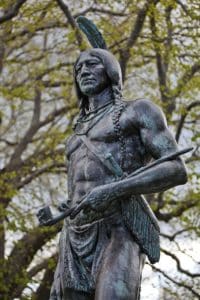Chief Massasoit was the leader of the Wampanoag and "Massasoit" of the Wampanoag Confederacy. He was the chief of the Wampanoag Indians when the Pilgrims arrived in Plymouth.

Jump to:
Chief Massasoit Facts: Overview
Massasoit lived in Montaup, a Pokanoket village at the site of what is now the town of Warren, Rhode Island. He held the allegiance of a number of lesser Pokanoket sachems.
As outbreaks of smallpox had devastated the Pokanoket, Massasoit sought an alliance with the English against the neighboring Narragansett, who controlled an area west of Narragansett Bay in present-day Rhode Island.
Massasoit forged critical political and personal ties with the colonial leaders John Carver, Stephen Hopkins, Edward Winslow, William Bradford, and Myles Standish – ties that grew out of a negotiated peace treaty on March 22, 1621.
Massasoit's alliance ensured that the Wampanoag remained neutral during the Pequot War in 1636.
According to English sources, Massasoit prevented the failure of the Plymouth Colony and the almost certain starvation that the Pilgrims faced during the earliest years of the colony's establishment.
Chief Massasoit Facts: Alliance with Pilgrims
There was some tension between Massasoit and the colonists when they refused to give up Squanto, whom Massasoit believed to have betrayed him. This was not resolved until a visit by Edward Winslow to Massasoit in March 1623 when Massasoit was ill, and Winslow nursed him.
After his recovery, Winslow reports that Massasoit said, "The English are my friends and love me." Moreover, Winslow also noted that Massasoit felt duty-bound to observe that "whilst I live, I will never forget this kindness they have showed me."
Further pressure on the alliance came in later years as the colonists were insistent upon the acquisition of new lands to support their growing colony.
In 1649, to alleviate tension and maintain the peace between his people and the colonists, Massasoit sold a tract of land fourteen miles square to Myles Standish and others of Duxbury. The sale took place atop Sachem Rock, a rock outcropping on the Pawtucket River in what is now East Bridgewater, Massachusetts.
For nearly forty years, the Wampanoag and the English of Massachusetts Bay Colony maintained an increasingly uneasy peace until Massasoit's death.
Throughout this time, and in order to maintain the peace, Massasoit sold lands that the English insisted on having. Roger Williams, when banished from the Massachusetts colony and on his way to Providence, was entertained by Massasoit for several weeks.
Chief Massasoit Facts: Family and Legacy
Massasoit had five children: "Moanam," or Wamsutta, who was born sometime between 1621 and 1624; Pometecomet, Metacomet, or Metacom; a third son, Sonkanuchoo; and two daughters, one named Amie and one whose name is unrecorded.
Soon after the death of Massasoit, Wamsutta and Pometecomet went to Plymouth and requested the Pilgrims to give them English names.
The court named them Alexander and Philip. Wamsutta (Alexander), the eldest, became sachem of the Pokanoket after the death of his father. Wamsutta died within a year, and his brother Metacom (Philip) succeeded him in 1662.
When Massasoit died, his son Wamsutta (Alexander) became his successor, but when Wamsutta also died in 1662, Metacom (Philip) succeeded him. Of Massasoit's five children, the only child to survive King Philip's War in 1676 was his daughter, Amie, wife of Tispaquin.
Massasoit was humane and honest, never violated his word, and constantly endeavored to imbue his people with a love of peace. He kept the Pilgrims advised of any warlike designs toward them by other tribes.
It is unclear when Massasoit died. Some accounts claim that Massasoit died as early as 1660; others contend that he died as late as 1662. Very likely, Massasoit was anywhere from eighty to ninety years old at the time.
